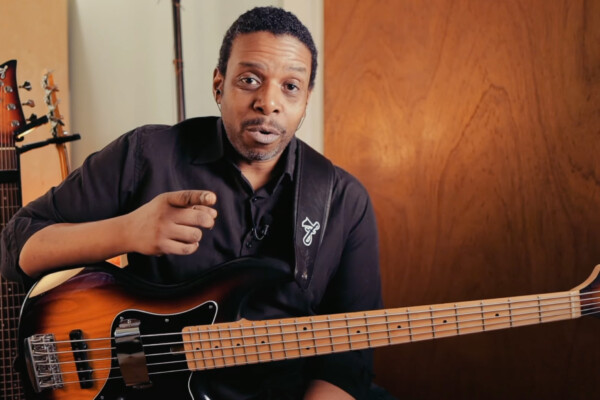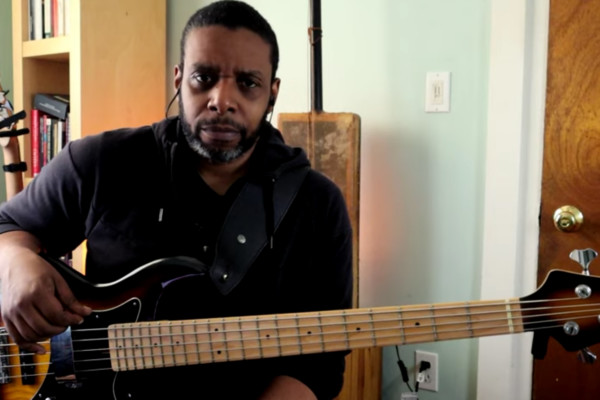Developing a Solid Groove

Q: So right now I’m trying to hack out my sense of groove and time, really trying to come down on that. I’ve noticed I can’t stay on a groove too long and start to play a lot of lines or rhythmic fills, not really being able to lay down a solid foundation and can’t stay tight? How do I go about practicing discipline and building up a solid sense of groove?
A: We play how we practice. So in my estimation, you may need to become a “student of the groove”!
I would make it my mission to become a student of various related styles, players, and bass lines. If we spend all of your shed time practicing licks and solos, we may have a hard time holding back when we hit the stage because we’ve been training ourselves to fill space instead of dropping the anchor and locking it down with the drummer. There’s plenty of time for self expression and licks, but I would make it your mission to stand out by virtue of how well you lock in that bass line and support the band.
- Make a list of players that you would like to emulate and learn from. Focus on some foundation-type players. They don’t have to be root rockers, but try and learn from the best. Think James Jamerson, Will Lee, Anthony Jackson, Derek Hodge, Me’Shell Ndegeocello, Nate Watts, Pino Palladino, etc. (You mentioned groove, so I’m focusing on those players, but feel free to pick players appropriate to whatever style of music you play).
- Start transcribing bass lines and learning them by ear. Don’t just get the basic gist of the tune and do your own thing, but really get inside the lines. Learn every nuance and articulation. Know it so well that you could sing it, note for note, slur for slur, trill for trill, bend for bend… Hear the line in your sleep.
- Try and compose some solid but harmonically interesting bass lines to different types of chord changes. Feel free to borrow changes from tunes you love. I like to write these down. I have a folder full of composed bass lines, licks and solos from back in my day. If you write them down, you’ll never forget or lose them. It’s fun to go back and relearn some of that stuff at times.
- Record those lines against the changes and pick them apart to decide on what you think works and what doesn’t. Then think about why something works and why something else didn’t. Make mental notes on what approaches led to the most successful lines.
- Play along with a lot of albums that contain the kind of lines you want to develop. Playing along, note for note, is a great way to train yourself to play in a musically contextual way.
- Force yourself to not to do everything that comes to mind. This takes a long time to internalize, but I can tell you from experience that it helps. I was the worst offender in the history of over-playing bassists. Once it finally sunk in after hearing some recordings, I would force myself to play licks no more often than every 8 bars. I had to mentally stop myself from playing everything that came to mind, otherwise it was a mess of chords, licks, and over-rhythmification. Eventually, I learned how to relax, listen and react musically. To play without an agenda or without forcing myself upon the song.
Basically, if you’ve internalized some bad musical habits, the only way to correct them is to get hyper-focused on what it is you actually want to play like and disallow yourself from doing it any other way. Try to never play anything out of habit, but rather with attention and focus. I find a lot of satisfaction from really locking down a groove with a drummer. Instead of focusing on licks and tricks, I’ll instead put all of my energy into articulating things the way I want and really locking into the drummers groove. You’ll find that really playing in time and trying to create one sound with the drummer can suck you in and give you all the satisfaction that you need without playing a lick every 2 or 4 bars – or getting super rhythmic and subdividing everything. There is an art to the placement of a quarter note. Focus on the micro-timing of your notes and making them lay in just the right spot. Focus on your articulation of every note. Focus on the length of every note. Hw does the line feel when you vary the length of different notes (long, short, or in between).
I also like to find great grooves on YouTube and play along. It doesn’t have to be fancy, just lock in. Here are a couple of examples:
Steve Jordan is the master of putting it right where it wants to be:
Adam Deitch is a real student of the groove:
Have fun!
Have a question for Damian Erskine? Send it to [email protected]. Check out Damian’s instructional books, Right Hand Drive and The Improviser’s Path.



